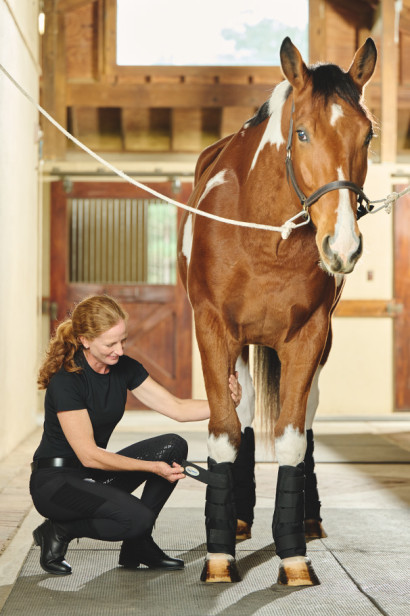Exploring the Holistic Approach of Equine Therapy for Individual Growth
Exploring the Holistic Approach of Equine Therapy for Individual Growth
Blog Article
Just How Laser Treatment in Equine Therapy Is Reinventing Veterinary Look After Horses
Laser therapy has actually arised as a transformative technique in equine veterinary treatment, giving a non-invasive option that accelerates healing and enhances total wellness. Leveraging exact light wavelengths, this innovative treatment boosts mobile regeneration, reduces inflammation, and minimizes pain. Its efficacy expands from musculoskeletal injuries to persistent conditions like osteoarthritis, considerably improving wheelchair and life high quality for steeds. The mobility and versatility of laser treatment tools even more emphasize their growing necessity among vets. As we check out the elaborate mechanics and real-world successes, the extensive effect on equine clinical practices ends up being significantly noticeable.
Understanding Laser Therapy

The innovation behind laser therapy is grounded in the concept of photochemistry, where photons are absorbed by chromophores within cells, causing increased ATP manufacturing and inflection of responsive oxygen species (Equine Therapy). This, consequently, advertises mobile spreading, lowers swelling, and accelerates healing. Vet specialists utilize different kinds of lasers, including low-level lasers (LLLT) and high-power Course IV lasers, relying on the specific therapeutic goals and the nature of the equine problem being dealt with
Various laser wavelengths and power settings are very carefully chosen to target different tissue depths and attain wanted professional outcomes. Safety methods are extremely important, as inappropriate use can result in thermal damage or suboptimal healing results. Thus, a comprehensive understanding of laser treatment's devices and applications is vital for its efficient implementation in equine vet technique.
Advantages for Equine Health
The myriad advantages of laser therapy for equine wellness include enhanced recovery, pain decrease, and boosted wheelchair. This advanced treatment method leverages particular wavelengths of light to pass through tissues, boosting cellular function and advertising rapid tissue fixing. The non-invasive nature of laser therapy makes certain minimal stress and anxiety and pain for the equine, assisting in a smoother recovery procedure.
Enhanced healing is one of the primary advantages, as laser treatment increases mobile regeneration and collagen synthesis. Pain decrease is attained via the anti-inflammatory effects of laser therapy, which decreases swelling and decreases the manufacturing of pain-inducing chemicals.
By reducing swelling and discomfort, and enhancing tissue repair, laser treatment assists in bring back joint function and muscle adaptability. Therefore, laser therapy stands as a transformative tool in modern horse vet care.
Common Problems Treated
Laser treatment has emerged as a functional therapy choice for a variety of usual equine conditions. Among these, musculoskeletal injuries are especially open to laser treatment. Equine Therapy. Soft tissue injuries, such as tendonitis and ligament pressures, advantage from the anti-inflammatory and analgesic results of laser therapies, which speed up healing and lower pain. Furthermore, laser treatment is effective for problems like osteoarthritis, where it aids alleviate joint inflammation and advertise tissue repair work.
Wound monitoring is another location where laser treatment has revealed considerable assurance. Chronic injuries or slow-healing website here abscess can be particularly difficult in steeds, however laser therapy improves mobile regeneration and enhances blood flow, hence accelerating the healing procedure. Laser therapies have actually been effectively employed in managing hoof problems such as laminitis and abscesses, relieving pain and promoting quicker recuperation.

Modern Technology Behind Laser Therapy
Past the myriad problems treatable with laser treatment, the innovation itself values better evaluation. At the heart of laser therapy is the use of specific wavelengths of light to penetrate cells and evoke organic actions. These wavelengths, usually ranging from 600 to 1000 nanometers, are precisely taken in by chromophores in the skin, muscle, and various other cells, initiating a cascade of mobile events.
Laser devices used in veterinary medication typically utilize low-level laser therapy (LLLT) or cool laser therapy. Unlike high-powered surgical lasers, these tools run at lower power levels, optimizing healing advantages while minimizing thermal damage. The energy from the laser light boosts adenosine triphosphate (ATP) manufacturing, enhances cellular metabolism, and increases tissue repair procedures.

Success Stories and Study

Showcasing the tangible benefits of laser therapy, various success stories and situation research studies brighten its transformative influence on equine wellness. One such instance entails a pureblooded racehorse struggling with persistent tendonitis. Typical treatments generated very little enhancement, however after integrating laser therapy into the regimen, the horse showed substantial decreases in swelling and discomfort within weeks, inevitably going back to affordable racing.
Another compelling example features a dressage steed diagnosed with serious pain in the back, restricting its performance. A vet team utilized low-level laser therapy (LLLT) to target the swollen locations, leading to marked improvement in versatility and a remarkable reduction in discomfort. Over several sessions, the steed reclaimed its peak type, showcasing the efficacy of laser treatment in addressing musculoskeletal concerns.
Furthermore, a research study conducted at a leading equine facility taken a look at 50 horses with numerous soft cells injuries treated with laser therapy. The results stood out: 85% of the horses showed sped up recovery times and enhanced wheelchair. These cases emphasize the adaptability and efficiency of laser treatment in equine medicine, supplying a non-invasive, scientifically-backed technique to enhancing recuperation and performance in steeds.
Final Thought
Laser treatment is reinventing equine veterinary care by providing a non-invasive treatment that accelerates healing, lowers swelling, and relieves discomfort. With its effectiveness in dealing with a variety of problems, from bone and joint injuries to chronic conditions like osteo arthritis, this innovation significantly improves equine wellness and movement. The mobility and flexibility of laser therapy additionally underscore its transformative effect on vet practices, solidifying its duty as a vital device in modern equine healthcare.
Report this page